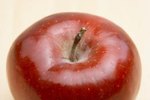
Cockatiels (Nymphicus hollandicus) are wee Australian parrots that make loving pets in homes all around the globe. As far as coloring goes, you just never know what to expect with the species. Avian breeders, through selective breeding, have introduced many new color morphs in cockatiels, including an albino variety.
Albino Cockatiel Origins
Albino cockatiels are produced by breeding two other cockatiel morphs together -- specifically whiteface cockatiels and lutino cockatiels. Lutino cockatiels often have entirely white or yellowish plumage, along with intense orange markings on their cheeks. Whiteface cockatiels don't have any of those orange facial markings, however. If you blend these two color morphs, the end result is a cockatiel that is purely white -- albino style. It isn't uncommon for people to mix lutino and albino cockatiels up.
Almost Completely White
Although albino cockatiels have totally white feathers, their bodies aren't 100 percent white, as they possess conspicuously bright red or deep red eyes. Since their eyes are free of pigment, they often don't adjust well in homes with particularly harsh and bright lighting conditions. Cockatiels on the whole typically have deep brown or blackish peepers.
Other Exciting Color Varieties
The color morphs in the cockatiel world are indeed diverse. Some cockatiels have "cinnamon" or deep brown or grayish-beige coloring. Other cockatiels have mostly cinnamon coloring, but with elements of pink on their feet and bills. These cockatiels are known as fallow cockatiels. Pearl cockatiels typically are yellow or white in color, but with noticeable gray borders to their feathers. Cockatiels often come in two colors, with clear distinctions between the foundations of their bodies and their tails, upper chests and wings, for example.
Although cockatiels are undeniably diverse color-wise, their actual coloration is often a little less vivid in comparison to that of fellow parrots such as macaws and parakeets.
Gray Cockatiels in Nature and Beyond
Cockatiels out in nature are markedly less diverse than their sometimes more glamorous captive counterparts. They're often known simply as "gray cockatiels." The male specimens have gray or deep brown feathers, with elements of orange and white throughout their bodies. The female specimens, like the males, are mostly gray too. They also feature somewhat lackluster orange markings on their cheeks. Gray cockatiels are also commonly seen as household pets, and are perhaps the most widespread of them all.
References
- University of Michigan Animal Diversity Web: Nymphicus Hollandicus
- The Bird Clinic: Cockatiel Concerns and Syndromes
- The National Cockatiel Society: Whiteface Cockatiels
- The Native Cockatiel Society of Australia: Lutino
- Lafeber Vet: Cockatiel Concerns
- Cockatiel Rescue: Cockatiel Types and Descriptions
- The Cockatiel Handbook; Mary Gorman
- Cockatiels; Belinda Ogle
- Cockatiels; Julie Rach Mancini
- BirdChannel.com: Lutino Mutation Cockatiel Birds
Photo Credits
-
Hemera Technologies/PhotoObjects.net/Getty Images




